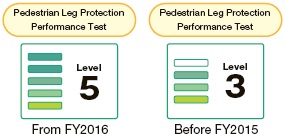
- TOP>
- Protect>
- Efforts of JNCAP>
- Car Assessment>
- Collision safety performance>
- Test Procedures and Evaluation Methods for Pedestrian leg Protection Performance Tests

In “Pedestrian Protection Performance”, the evaluation area for “Leg Protection” is enlarged from 2024 to include a new evaluation part of femur in addition to the existing evaluation for knee and tibia.
This evaluation uses a new leg impactor of aPLI (adavanced Pedestrian Leg Form Impactor). The aPLI was developed to be more closely to a human leg by adding a mass simulating the effects of the upper body to a conventional leg impactor (FLEX-PLI) which represents the leg of an adalt male. The leg impactor is fired from the testing machine at a speed of 40 km/h into the bumper of the test car. Injuries to the femur, knee and shin area at the point of impact are measured and evaluated on a five-point scale for the degree of injury.
The area to be evaluated by firing the leg impactor (hereinafter referred to as “test area”) is the bumper excluding the sides. The leg injury values are measured by dividing test area into six segments from left to right, and selecting the areas considered to be hazardous.
The number of points to fire the leg impactor in the test area varies from 2 to 6 depending on the test vehicle. However, in the event that there are locations thought to pose a danger even outside the test area, a test is conducted for these locations. For overall evaluation, the higher levels or the higher scores even at the same level indicate better pedestrian leg protection performance.
It is not possible to make direct comparisons of safety performances based on their scores with the vehicle models evaluated in the past.
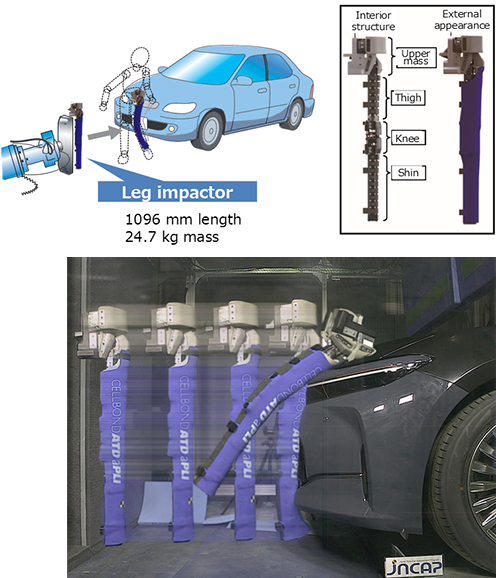
In this test, a “leg impactor” (FLEX-PLI) dummy made to represent the leg of an adult male is launched by the testing machine at a speed of 40 km/h at the bumper of the test car. Injuries to the knee and shin area at the point of impact are measured and evaluated on a four-point scale for the degree of injury when the vehicle collides with a pedestrian. This test is applicable for cars for which the height up to the lower edge of the bumper is less than 425 mm. (The test may be conducted even if the height up to the lower edge of the bumper is 425 mm or greater.)
The test area of the bumper that is evaluated in the leg impactor launch test comprises six segments between the bumper (excluding the sides), and the number of locations at which leg injury is measured will vary from 2 to 6 depending on the test vehicle (In the event that there are locations even outside this area that are thought to pose a danger, a test is conducted for these areas).
In the results of evaluation, a higher value indicates better pedestrian leg protection performance.
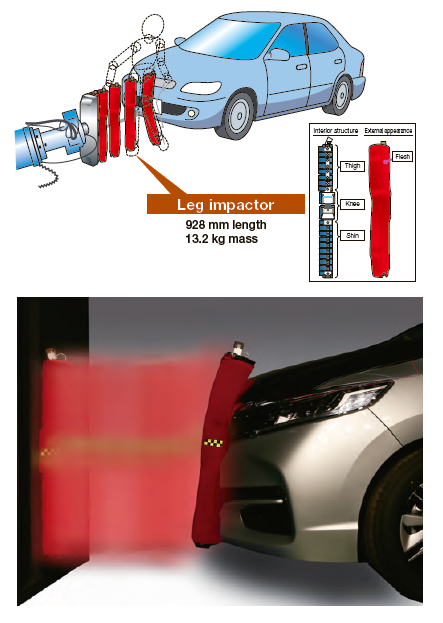
The bumper excluding the sides is the basically the test area and this area is divided crosswise into three sections numbered Area L1, Area L2 and Area L3 (from right to left).
Each of these three areas is further subdivided into two. Starting from the right the subdivided areas are labeled as L1A, L1B, L2A, L2B, L3A and L3B.
One or two points in each of the three areas (L1, L2 and L3) that are thought to have the highest injury criteria are selected (although they must be in different sections) and with the injury criteria of the knee and shin obtained from the test as representative criteria, a score is calculated using the evaluation function (sliding scale).
The points are weighted for both the femur, knee and shin areas and the score for each area is calculated. Each area is averaged and the total average score is given as an evaluation.
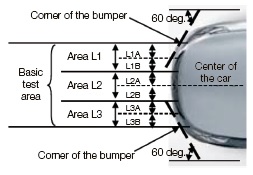
Based on the measurements from the sensors attached to the leg impactor, the femur and tibia bending moment and elongation of the knee area medial collateral ligament (MCL) are calculated using the evaluation function (sliding rule).
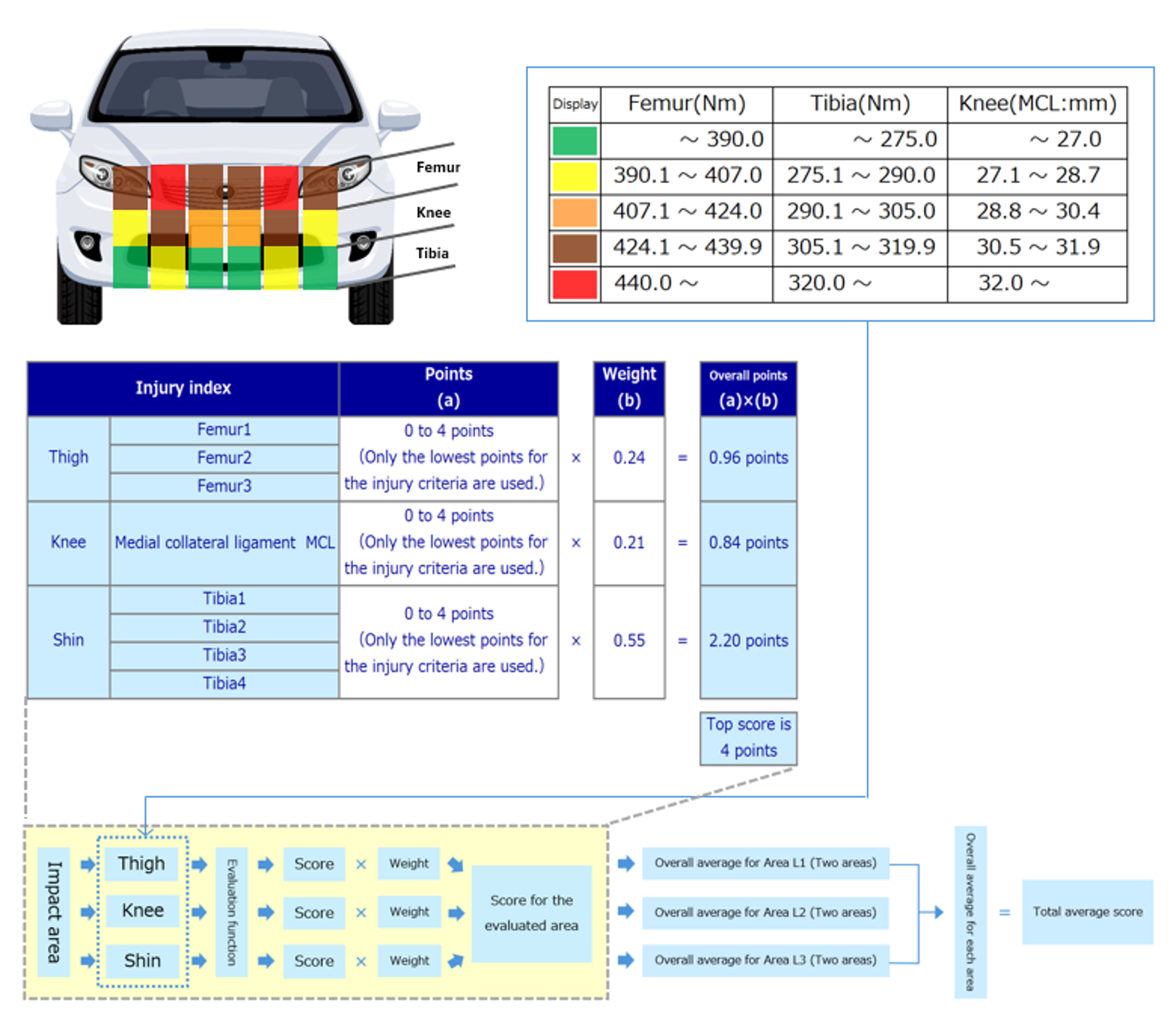
The bumper area (excluding the sides) is the basic test area and this area is divided crosswise into three sections numbered Area L1, Area L2 and Area L3 (from right to left).
Each of these three areas is further subdivided into two.
Starting from the right the subdivided areas are labeled as L1A, L1B, L2A, L2B, L3A and L3B.
One or two points in each of the three areas (L1, L2 and L3) that are thought to have the highest injury criteria are selected (although they must be in different sections) and with the injury criteria of the knee and shin obtained from the test as representative criteria, as core is calculated using the evaluation function (sliding scale).
The points are weighted for both the knee and shin areas and the score for each area is calculated. Each area is averaged and the total average score is given as an evaluation.

Based on the measurements from the sensors attached to the leg impactor, the tibia bending moment and elongation of the knee area medial collateral ligament (MCL), anterior cruciate ligament (ACL) and posterior cruciate ligament (PCL) are calculated using the evaluation function (sliding rule). (As there is Level 2 was above two points and less than 2.67 points. Level 3 was above 2.67 and less than 3.33 points.
Level 4 was above 3.33 points and less than 4.00 points. no risk curve injury criteria for the ACL and PCL, a score of 0, shown as red, is given if the value is 13.0 mm or greater, and the score is represented by the MCL score if the value is less than 13.0 mm.)
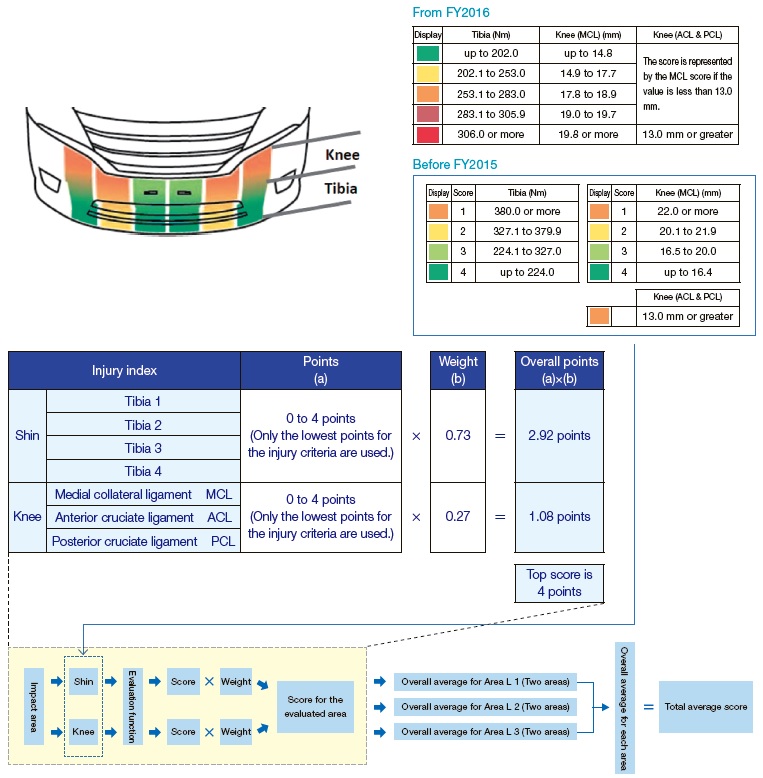
The overall average score is evaluated on a five level rating and to accurately differentiate between the evaluation of different vehicles, the current standard is taken into consideration with two points out of a top score of four being rated as Level 1, while above that is divided into four levels. Level 2 is above two points and less than 2.50 points. Level 3 is above 2.50 and less than 3.00 points. Level 4 is above 3.00 points and less than 3.50 points. Level 5 is above 3.50 points.
Before FY2015, the overall average score was evaluated on a four level rating with two points out of a top score of four being rated as Level 1, while above that was divided into three levels. Level 2 was above two points and less than 2.67 points. Level 3 was above 2.67 and less than 3.33 points. Level 4 was above 3.33 points and less than 4.00 points.
